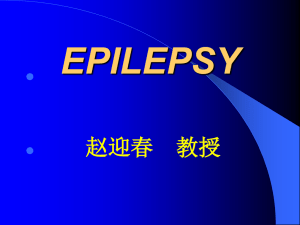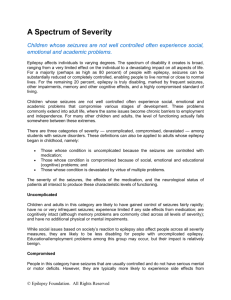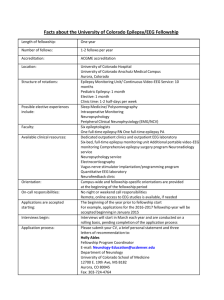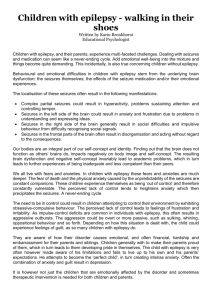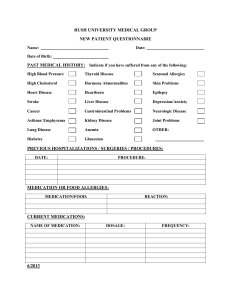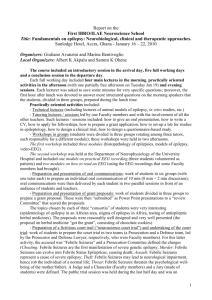Epilepsy Smt X, aged 10 Medical history The child had had a variety
advertisement
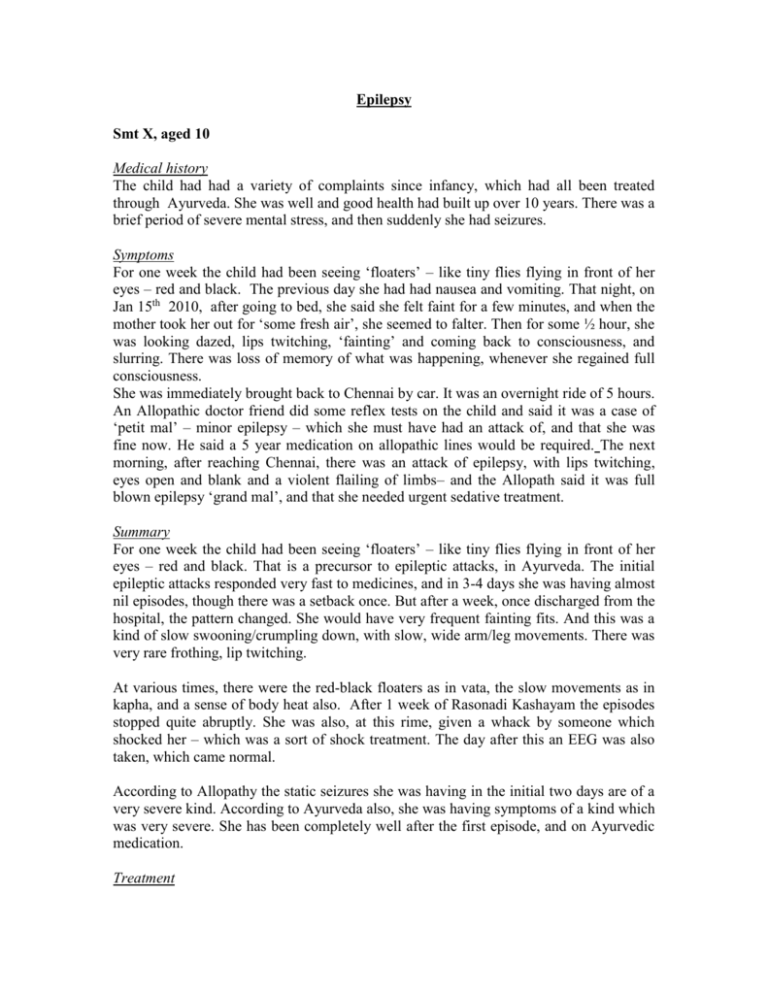
Epilepsy Smt X, aged 10 Medical history The child had had a variety of complaints since infancy, which had all been treated through Ayurveda. She was well and good health had built up over 10 years. There was a brief period of severe mental stress, and then suddenly she had seizures. Symptoms For one week the child had been seeing ‘floaters’ – like tiny flies flying in front of her eyes – red and black. The previous day she had had nausea and vomiting. That night, on Jan 15th 2010, after going to bed, she said she felt faint for a few minutes, and when the mother took her out for ‘some fresh air’, she seemed to falter. Then for some ½ hour, she was looking dazed, lips twitching, ‘fainting’ and coming back to consciousness, and slurring. There was loss of memory of what was happening, whenever she regained full consciousness. She was immediately brought back to Chennai by car. It was an overnight ride of 5 hours. An Allopathic doctor friend did some reflex tests on the child and said it was a case of ‘petit mal’ – minor epilepsy – which she must have had an attack of, and that she was fine now. He said a 5 year medication on allopathic lines would be required. The next morning, after reaching Chennai, there was an attack of epilepsy, with lips twitching, eyes open and blank and a violent flailing of limbs– and the Allopath said it was full blown epilepsy ‘grand mal’, and that she needed urgent sedative treatment. Summary For one week the child had been seeing ‘floaters’ – like tiny flies flying in front of her eyes – red and black. That is a precursor to epileptic attacks, in Ayurveda. The initial epileptic attacks responded very fast to medicines, and in 3-4 days she was having almost nil episodes, though there was a setback once. But after a week, once discharged from the hospital, the pattern changed. She would have very frequent fainting fits. And this was a kind of slow swooning/crumpling down, with slow, wide arm/leg movements. There was very rare frothing, lip twitching. At various times, there were the red-black floaters as in vata, the slow movements as in kapha, and a sense of body heat also. After 1 week of Rasonadi Kashayam the episodes stopped quite abruptly. She was also, at this rime, given a whack by someone which shocked her – which was a sort of shock treatment. The day after this an EEG was also taken, which came normal. According to Allopathy the static seizures she was having in the initial two days are of a very severe kind. According to Ayurveda also, she was having symptoms of a kind which was very severe. She has been completely well after the first episode, and on Ayurvedic medication. Treatment During the first 24 hours, the patient had very long seizures. Later we learnt that these are called static seizures, and can even cause cardiac arrest. The patient actually had very acute pain in the heart for about half an hour, for which the doctor was prepared with medication – but it subsided. The patient was immediately taken to the Vaidyasala. Over the first three days, there were episodes with violent hand, leg movement, jerky head and neck movements, lip twitching and foamy frothing at the mouth, and hand tremors at night. Dhoopam(fumigation) would immediately bring her out of the attack, but she would again go into another attack. She would have very bad dreams at night. Nausea was also there. Medicines given: Saraswatha Churnam, Manasa mitram, Smriti Sagara Rasa, Jyothismathi Tailam, Maha Panchagavya Ghritam, Saraswatharishtam, and fumigation with medicines. Over the next 2 days, the episodes came down. But there was nausea, and then there were Pittaja symptoms like 'metal taste', very bad temper, fever, joint pains, small boils on thigh, urine deep yellow, burning, involuntary dripping of urine, with a streak of blood. Added Sudarsana Choornam, Dhanvantra gutika, Vayu gutika, Brihatyadi Kashayam (Replaced Maha Panchagavyam by MahaTiktakam) and Nasyam with Svarasa (juice) of Nochi (Nirgundi) leaves. (The nasyam caused much burning, and eyes would stay blood shot for ½ hr. But with that the nausea stopped.) Over the next 2 days the frequency of episodes increased. Maha Tikta Gritham was again replaced by Maha Panchagavyam. Patient was discharged from the vaidyasala after a week, and treatment continued at home. (After now, the pattern of episodes seemed to change to - very frequent fainting spells. But there was some flailing of arms, though very little or no frothing, and lip twitching. Also, sometimes there was strange behaviour. And difficulty in sleeping – and patient quoting fear of nightmares.) These medicines were added (+Kushmanda rasa,Yashti for 3 days) (+Shatavari-milk kashayam twice a day) (+Vacha, honey for 3 days – milk,rice,wheat diet) After a very high frequency of episodes for 2 days, she improved dramatically, till a severe disappointment over missing a dance programme seemed to aggravate the problem. The number of episodes again went up. That day she had burning urination, thirst, loose motions, stomach ache. Lips, eyes and nose were burning. The next morning she woke up very exhausted and her behavior was strange. Varanadi Kashayam was added. Next day it was replaced by Rasonadi Kashayam. Two weeks were over. Abhyangam+matra vasti was given. Abhyangam daily from today at home. Next two days there were many episodes. But after the 20th day, all episodes ended. (At the same time we met an allopath who saw her and said that it was 'pseudo epilepsy', which the child was faking! He also did an EEG then which showed normalcy. But the fact was that though her problem now was not exactly epileptic, and more like fainting, her initial condition had been epilepsy of a very severe form- as also agreed upon by two allopathic doctors who saw her. But this doctor dismissed that she had ever had epilepsy.) A month since the first day, the child was well, but her energy levels were very low. A small walk to two streets away would give her a leg pan and tire her. Rajayapana Vasti was given on 17th Feb. (15th and 16th she has had abhyangam in the clinic.) 17th Sneha Vasti (100ml) 18th Kashaya vasti (500ml), Sneha Vasti (75ml) After the vasti, her medicines have been reduced to Manasa mitram 1-0-1 Sarasvatha churnam ½ tsp – 0 – ½ tsp Panchagavya gritham 5ml – 0 – 5ml Jyothishmati Tailam 7drops – 0 - 7 drops Saraswatharishtam 15ml – 0 – 15ml Smriti Sagara Rasa ½ tab - ½ tab Abhyangam with Lakshadi Tailam Nasyam with Nochi svarasa started 5 days after vasti Shatavari ksheerapakam. As on August, she has been well, and energy levels are much better. Mentally her academic quickness which had slowed after the attack came back to normalcy. For 3 months there were periodic 'floaters' seen. Six months after the first attack, the child has come back to complete normalcy, and rejoined school. Medication is continuing. These medicines are anyway good for the mind and for health. And given the fact that she had had a severe kind of epilepsy, she is kept on these medicines for a longer period. Allopathic opinions An allopathic doctor friend initially did some reflex tests on the child and said it was a case of ‘petit mal’ – minor epilepsy – which she must have had an attack of, and she was fine now. He said that a 5 year medication on Allopathic lines should sort her out. The next morning there was an attack of epilepsy, with lips twitching, eyes open and blank and a violent flailing of limbs– and the Allopath said it was full blown epilepsy ‘grand mal’, and that she needed urgent sedative treatment. Another allopathic friend came to see the patient at the vaidyasala. Allopathically, she found the fact that the seizures were non-febrile (not related to fever) of concern. But she spoke to two doctor friends and after discussing the case said - it did not seem to be because of a specific internal growth – and was more a generalized epilepsy. (That reassured the parents as they were worried about 'brain tumours' – even though they believed that even this would be best handled by Ayurveda.) After 2 weeks, she was taken to to Dr. V, a well known paediatrician. By now her seizures had stopped, and she only had the 'fainting spells'. The situation was explained to him. He called in the child and spoke to her. She had an attack then, and he gave her a hit. She did not come out of the faint immediately. Later when she came out, he shouted her out of the room. He later told the parents that she has ‘pseudo epilepsy’. He said that many children ‘pretend’ consciously or unconsciously – and a clear indication is that she has her eyes closed (in epileptic fits, eyes stay open as the attack is so sudden), and that she swoons so slowly. He recommended an EEG the next day to confirm, as sometimes pseudo epilepsy overlies real epilepsy. The next day the parents went for an EEG. It was a 2 hour video EEG, and the doctor saw it and said she had no abnormal activity at all. That the whole thing was pseudo from day 1 – as nothing at all showed on the EEG. (But the other two allopathic friends who saw her in the initial period confirmed that the child had had real epileptic attacks, in allopathic terms – as her lip had twitches, eyes had stayed open during attacks in those initial days). So the ayurvedic medication over these days seems to have completely normalized the brain graph. The Allopath, who had seen the initial attack could not dismiss it. So he rejected the EEG, saying that ‘no result’ can not mean anything, and an MRI is needed anyway, or a 24 hour EEG. But the parents were told by Dr. V that for this reason only he prescribed a 2 hour video EEG, which would capture a complete picture. Another Allopathic doctor the parents met later, from the description of the seizures on day 2, of extremely long attacks – said that it seemed an extreme sort of epilepsy – static attacks. His surmise was also that the attacks pattern after this got cured. A pattern of some 50- 100 brief attacks in a day could have allopathically been something else – maybe hypotension. He said that no child could be ‘normal’ after 100 epileptic fits a day. Static epilepsy is supposed a very serious condition. It can apparently lead into a cardiac arrest if it's not stopped. (And as a matter of fact, there was severe heart pain during the first day, of very long seizures.) In case the parents had taken Allopathic tests directly, without Ayurvedic treatment, the EEG would have shown epileptic patterns, and they may have been sent the MRI route. For static seizures, very probably extremely powerful tranquilizers would have been injected, which are dangerous. Having come directly to competent Ayurvedic physician, saved them from much possible trouble, and gave the patient the best route to health and recovery. Subsequently two children had come to Sanjeevani who had had severe seizures and were treated with very strong medication in Allopathy, and had been reduced to a vegetable state. Another young patient who came to Sanjeevani after five years of Allopathic antiseizure medication, told us that Allopathic medication had definitely made his mind slow down, and also his tendency to catch infections had gone up manifold. He had had to suddenly stop the medication because of liver damage, which was a predicted side effect. He underwent panchakarma, and his allopathic medication was stopped, and he was put on Ayurvedic medicines. He said that now he felt much more alert. His agitation level had also come down. Side effects of a common epileptic drug is appended below SERIOUS DERMATOLOGIC REACTIONS AND HLA-B*1502 ALLELE SERIOUS AND SOMETIMES FATAL DERMATOLOGIC REACTIONS, INCLUDING TOXIC EPIDERMAL NECROLYSIS (TEN) AND STEVENS-JOHNSON SYNDROME (SJS), HAVE BEEN REPORTED DURING TREATMENT WITH TEGRETOL. THESE REACTIONS ARE ESTIMATED TO OCCUR IN 1 TO 6 PER 10,000 NEW USERS IN COUNTRIES WITH MAINLY CAUCASIAN POPULATIONS, BUT THE RISK IN SOME ASIAN COUNTRIES IS ESTIMATED TO BE ABOUT 10 TIMES HIGHER. STUDIES IN PATIENTS OF CHINESE ANCESTRY HAVE FOUND A STRONG ASSOCIATION BETWEEN THE RISK OF DEVELOPING SJS/TEN AND THE PRESENCE OF HLA-B*1502, AN INHERITED ALLELIC VARIANT OF THE HLA-B GENE. HLAB*1502 IS FOUND ALMOST EXCLUSIVELY IN PATIENTS WITH ANCESTRY ACROSS BROAD AREAS OF ASIA. PATIENTS WITH ANCESTRY IN GENETICALLY AT-RISK POPULATIONS SHOULD BE SCREENED FOR THE PRESENCE OF HLA-B*1502 PRIOR TO INITIATING TREATMENT WITH TEGRETOL. PATIENTS TESTING POSITIVE FOR THE ALLELE SHOULD NOT BE TREATED WITH TEGRETOL UNLESS THE BENEFIT CLEARLY OUTWEIGHS THE RISK (SEE WARNINGS AND PRECAUTIONS/LABORATORY TESTS). APLASTIC ANEMIA AND AGRANULOCYTOSIS APLASTIC ANEMIA AND AGRANULOCYTOSIS HAVE BEEN REPORTED IN ASSOCIATION WITH THE USE OF TEGRETOL. DATA FROM A POPULATION-BASED CASE CONTROL STUDY DEMONSTRATE THAT THE RISK OF DEVELOPING THESE REACTIONS IS 5-8 TIMES GREATER THAN IN THE GENERAL POPULATION. HOWEVER, THE OVERALL RISK OF THESE REACTIONS IN THE UNTREATED GENERAL POPULATION IS LOW, APPROXIMATELY SIX PATIENTS PER ONE MILLION POPULATION PER YEAR FOR AGRANULOCYTOSIS AND TWO PATIENTS PER ONE MILLION POPULATION PER YEAR FOR APLASTIC ANEMIA. ALTHOUGH REPORTS OF TRANSIENT OR PERSISTENT DECREASED PLATELET OR WHITE BLOOD CELL COUNTS ARE NOT UNCOMMON IN ASSOCIATION WITH THE USE OF TEGRETOL, DATA ARE NOT AVAILABLE TO ESTIMATE ACCURATELY THEIR INCIDENCE OR OUTCOME. HOWEVER, THE VAST MAJORITY OF THE CASES OF LEUKOPENIA HAVE NOT PROGRESSED TO THE MORE SERIOUS CONDITIONS OF APLASTIC ANEMIA OR AGRANULOCYTOSIS. BECAUSE OF THE VERY LOW INCIDENCE OF AGRANULOCYTOSIS AND APLASTIC ANEMIA, THE VAST MAJORITY OF MINOR HEMATOLOGIC CHANGES OBSERVED IN MONITORING OF PATIENTS ON TEGRETOL ARE UNLIKELY TO SIGNAL THE OCCURRENCE OF EITHER ABNORMALITY. NONETHELESS, COMPLETE PRETREATMENT HEMATOLOGICAL TESTING SHOULD BE OBTAINED AS A BASELINE. IF A PATIENT IN THE COURSE OF TREATMENT EXHIBITS LOW OR DECREASED WHITE BLOOD CELL OR PLATELET COUNTS, THE PATIENT SHOULD BE MONITORED CLOSELY. DISCONTINUATION OF THE DRUG SHOULD BE CONSIDERED IF ANY EVIDENCE OF SIGNIFICANT BONE MARROW DEPRESSION DEVELOPS.
